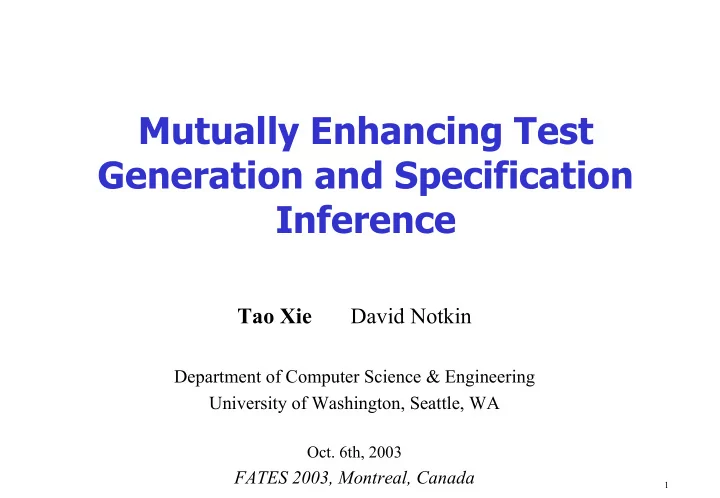

Mutually Enhancing Test Generation and Specification Inference Tao Xie David Notkin Department of Computer Science & Engineering University of Washington, Seattle, WA Oct. 6th, 2003 FATES 2003, Montreal, Canada 1
Synopsis • Need specs for (many kinds of) test generation • Need tests for dynamic spec inference • We have applied feedback loop between these approaches that •aids in test generation •improving specs and helping in producing oracles •aids in spec inference •improving the underlying test suites Spec-based test generation (Likely) Tests Specs Dynamic spec inference 2
Outline • Motivation • Feedback Loop between Test Generation and Spec Inference • Related Work • Conclusion 3
Test Generation • White-box test generation + Cover structural entities, e.g. statement, branch – Test oracle problem - Rely on uncaught runtime exceptions or program crashes • Black-box test generation + Use specs to guide test generation + Use specs to produce test oracles – Lack of specs problem 4
Dynamic Spec Inference • A formal specification: desired behavior and written before code • An operational abstraction: observed behavior and induced dynamically from program executions [Harder et al. 03] in form • Operational abstraction ≈ formal specification Dynamic spec inference ≈ operational abstraction generation Running insufficient tests produce low-quality specs 5
Dynamic Spec Inference (cont.) • Axiomatic specification inference • Daikon [Ernst et al. 01] • Algebraic specification inference • [Henkel & Diwan 03] • Protocol specification inference • Strauss [Ammons et al. 02] , Hastings [Whaley et al. 02] , [Hagerer et al. 02] 6
Circular Dependency • Circular dependency: spec-based test generation and dynamic spec inference • Solution: win-win feedback loop Better spec ⇔ better tests • expose faults or closer to exercise new actual behavior specs Spec-based test generation (likely) Tests Specs Dynamic spec inference 7
Feedback Loop • Inferred Specs � Test Generation Lack of specs • Reduce the scope of analysis problem • Generated Tests � Spec Inference Insufficient • Verify/refine the inferred specs test problem • Spec-violating Tests � Test Selection Test oracle • Inspection and test augmentation problem Spec-based test generation (likely) Tests Specs Dynamic spec inference 8
Outline • Background • Feedback Loop between Test Generation and Spec Inference • Related Work • Conclusion 9
Feedback Loop Framework Automatically Selected generated The existing tests test inputs test suite Test Test (manual tests) Selection Generation Automatically Program generated Likely test inputs specs Data trace Trace Spec Collection Inference 10
Test Generation Based on Inferred Specs • Generate test inputs • preconditions (axiomatic specs) • transitions (protocol specs) • axioms (algebraic specs) • Over-constrained specs • leave (maybe important) legal inputs untested • Solutions: • remove precondition guards (axiomatic specs) • complement-transitions (protocol specs) • other method call pairs (algebraic specs) 11
Test Selection - I • Execution of a test input: • no specification violations/exceptions • throw uncaught exceptions • A fault or illegal input • violate over-constrained postconditions/axioms • Existing test inputs are insufficient • violate true postconditions/axioms • A fault or illegal input 12
Test Selection - II • Human inspection: • illegal input: • Add preconditions or adopt defensive programming • legal input: • Fault exposure: fix bug and augment regression test suite • Normal, but new feature being exercised: augment regression test suite • Complementary technique: select tests exercising new structural entities • We observed that the number of selected test was relatively small 13
Iterations • Iterates until • no spec violations or inferred specs remain the same • user-specified max # iteration has been reached • In the subsequent iteration, spec inference is based on: • the existing test suite augmented by • selected violating tests • all generated tests 14
Outline • Motivation • Feedback Loop between Test Generation and Spec Inference • Related Work • Conclusion 15
Related Work • Feedback loop between static analyses • Program abstraction and model checking [Ball et al. 01] • Annotation guess and theorem proving [Flanagan et al. 01] • Assumption generation and model checking [Giannakopoulou et al. 02, 03] • Feedback loop between static and dynamic analyses • Finite state verification and testing [Naumovich et al. 00] • Other feedback loops: • Test data generation and branch predicate constraint solving [Gupta et al. 98] • Automata learning and testing/model checking [Peled et al. 99, 02] 16
Outline • Motivation • Feedback Loop between Test Generation and Spec Inference • Related Work • Conclusion 17
Conclusion • Feedback loop between test generation and spec inference • Axiomatic specs (integration of Daikon and Jtest) [ASE 03] • Algebraic/protocol specs (ongoing work) • Aids in test generation • improving specs and helping in producing oracles • Aids in spec inference • improving the underlying test suites 18
Questions? 19
Recommend
More recommend